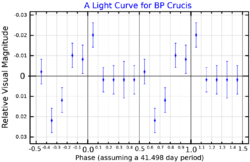BP Crucis
Topic: Astronomy
 From HandWiki - Reading time: 4 min
From HandWiki - Reading time: 4 min
| Observation data Equinox J2000.0]] (ICRS) | |
|---|---|
| Constellation | Crux |
| Right ascension | 12h 26m 37.561s[1] |
| Declination | −62° 46′ 13.16″[1] |
| Apparent magnitude (V) | 10.83[2] |
| Characteristics | |
| Spectral type | B1 Ia+[3] |
| U−B color index | +0.42[2] |
| B−V color index | +1.76[2] |
| Variable type | Ellipsoidal + X-ray[4] |
| Astrometry | |
| Parallax (π) | 0.34 ± 0.75[5] mas |
| Distance | 3,040[2] pc |
| Absolute magnitude (MV) | −7.47[3] |
| Orbit | |
| Period (P) | 41.498 days[2] |
| Semi-major axis (a) | 0.00029" (191.7 R☉[6]) |
| Eccentricity (e) | 0.462[2] |
| Inclination (i) | 60[6]° |
| Details | |
| Mass | 43[3] M☉ |
| Radius | 70[3] R☉ |
| Luminosity (bolometric) | 470,000[3] L☉ |
| Surface gravity (log g) | 2.38[3] cgs |
| Temperature | 18,100[3] K |
| Rotational velocity (v sin i) | 55[3] km/s |
| Other designations | |
| Database references | |
| SIMBAD | data |
BP Crucis (x-ray source GX 301-2) is an X-ray binary system containing a blue hypergiant and a pulsar.
System
BP Crucis is considered as the optical counterpart to the X-ray source GX 301-2. The system consists of a massive hypergiant star and a neutron star in an eccentric 41.5 day orbit. The distance is likely to be between three and four thousand parsecs. It is heavily reddened and has a K-band infrared magnitude of 5.72.[2]
There is a mass transfer from the hypergiant to the pulsar which occurs via a dense accretion disc. This produces a cyclotron effect with electron energies of 37 and 48 keV.[7]
Variability
The system shows both optical and x-ray variability. Although no eclipses are observed, the x-ray luminosity varies during the orbit with large x-ray flares being observed during periastron passages.[7] The system is an optical variable showing brightness changes of up to 0.08 magnitudes at visible wavelengths. These have been attributed to ellipsoidal variations as the hypergiant rotates and to α Cygni variability. There is an intrinsic pseudo-period of 11.9 days as well as small variations corresponding to the orbital period.[8] That X-ray emission comes not from the neutron star itself, but rather represent a radiation re-emitted by optically thick accretion shell.[9]
Properties
BP Crucis is around 43 times as massive as the Sun, it is also one of the most luminous stars known in the Galaxy, with an estimated bolometric luminosity of around 470,000 times that of the Sun and a radius 70 times that of the Sun.
The neutron star appears to belong to the "high mass" variety being at least 1.85 M☉. It is very likely to have a mass less than 2.5 M☉ as the theoretical maximum mass based on the equation of state for a neutron star.[2] The pulsar has a spin period of 685 seconds, but shows relatively large spindown rates thought to be due to its strong magnetic field, and also occasional spinups due to interaction with the accretion disk. It is calculated that a slowly spinning neutron star could be spun up to the current rotation rate by accretion in only ten years.[10]
References
- ↑ 1.0 1.1 van Leeuwen, Floor (November 2007), "Validation of the new Hipparcos reduction", Astronomy and Astrophysics 474 (2): 653–664, doi:10.1051/0004-6361:20078357, Bibcode: 2007A&A...474..653V Note: see VizieR catalogue I/311.
- ↑ 2.0 2.1 2.2 2.3 2.4 2.5 2.6 2.7 Kaper, L.; Van Der Meer, A.; Najarro, F. (2006). "VLT/UVES spectroscopy of Wray 977, the hypergiant companion to the X-ray pulsar GX301-2". Astronomy and Astrophysics 457 (2): 595–610. doi:10.1051/0004-6361:20065393. Bibcode: 2006A&A...457..595K.
- ↑ 3.0 3.1 3.2 3.3 3.4 3.5 3.6 3.7 Clark, J. S.; Najarro, F.; Negueruela, I.; Ritchie, B. W.; Urbaneja, M. A.; Howarth, I. D. (2012). "On the nature of the galactic early-B hypergiants". Astronomy & Astrophysics 541: A145. doi:10.1051/0004-6361/201117472. Bibcode: 2012A&A...541A.145C.
- ↑ Samus, N. N. et al. (2009). "VizieR Online Data Catalog: General Catalogue of Variable Stars (Samus+ 2007-2013)". VizieR On-line Data Catalog: B/GCVS. Originally Published in: 2009yCat....102025S 1. Bibcode: 2009yCat....102025S.
- ↑ Gaia Collaboration (2016). "VizieR Online Data Catalog: Gaia DR1 (Gaia Collaboration, 2016)". VizieR On-line Data Catalog: I/337. Originally Published in: Astron. Astrophys. 1337. Bibcode: 2016yCat.1337....0G.
- ↑ 6.0 6.1 Waisberg, I.; Dexter, J.; Pfuhl, O.; Abuter, R.; Amorim, A.; Anugu, N.; Berger, J. P.; Blind, N. et al. (2017). "Submilliarcsecond Optical Interferometry of the High-mass X-Ray Binary BP Cru with VLTI/GRAVITY". The Astrophysical Journal 844 (1): 72. doi:10.3847/1538-4357/aa79f1. Bibcode: 2017ApJ...844...72W.
- ↑ 7.0 7.1 Walter, Roland; Lutovinov, Alexander A.; Bozzo, Enrico; Tsygankov, Sergey S. (2015). "High-mass X-ray binaries in the Milky Way. A closer look with INTEGRAL". The Astronomy and Astrophysics Review 23: 2. doi:10.1007/s00159-015-0082-6. Bibcode: 2015A&ARv..23....2W.
- ↑ Van Genderen, A. M.; Sterken, C. (2007). "Orbital effects on the light curves of eta Car, BP Cru, and Other Eccentric Binaries". Information Bulletin on Variable Stars 5782: 1. Bibcode: 2007IBVS.5782....1V.
- ↑ Ji, L. et al. (2021), "X-ray reprocessing in accreting pulsar GX 301-2 observed with Insight-HXMT", Monthly Notices of the Royal Astronomical Society 501 (2): 2522–2530, doi:10.1093/mnras/staa3788
- ↑ Ikhsanov, N. R.; Likh, Yu. S.; Beskrovnaya, N. G. (2014). "Spin evolution of long-period X-ray pulsars". Astronomy Reports 58 (6): 376. doi:10.1134/S1063772914050035. Bibcode: 2014ARep...58..376I.
External links
 |
 KSF
KSF
